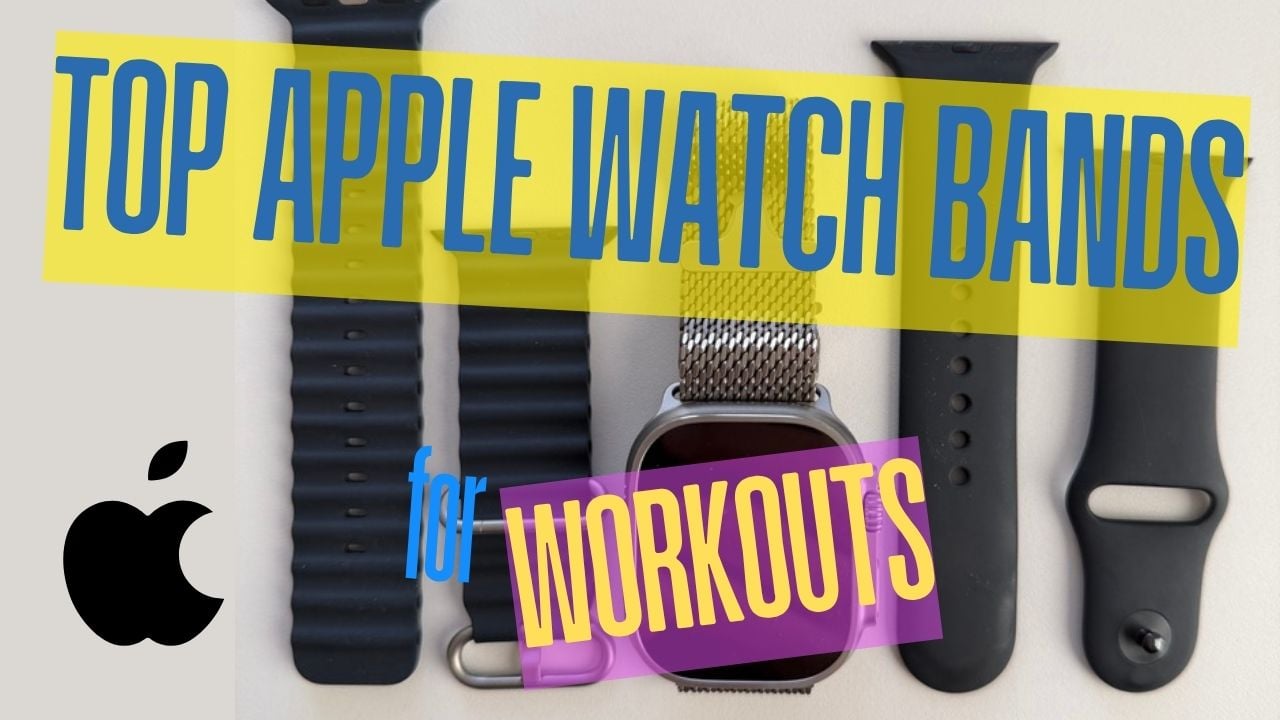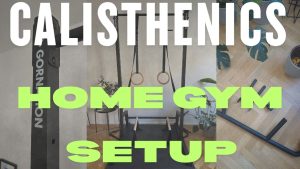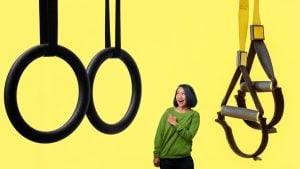(My 3-Year Ultra Experience & Comparative Review)
Wearing an Apple Watch Ultra day in, day out means one thing: you feel every choice you make about the strap. The wrong band can chafe, slip, lose data accuracy, or just become annoying. Over the past three years, I’ve run calisthenics sessions, functional training, CrossFit-esque workouts, cycling, running, and nightly sleep tracking — all with the same watch but different bands. In this article, I walk you through my experiences (warts and all), complemented by what others have said, what the materials and manufacturing imply, and how to pick a band that truly works for you — whether you’re chasing gains or closing rings.
If you are workout out at home, make sure to check out my picks for the
➡️ Best Calisthenics Equipment and my own home gym setup.
If you need training guidance check our
▶️ Free calisthenics workout programs and the Best Calisthenics Apps we tested.
I tested four bands originally (Sport Band, Ocean Band, Titanium Milanese Loop, and Trail Loop). After months of real-world trials, I eliminated the Trail Loop: while comfortable for casual wear, I found it suboptimal for high-intensity sweat sessions or water exposure (it traps moisture, dries slowly, and the Velcro weakened after ~6 months). So I’ll focus here on the three bands I settled on: the Sport Band, Ocean Band, and Titanium Milanese Loop. Each has strengths and trade-offs; my goal is to give you a clear, data-informed guide so you can pick (or rotate) what fits your priorities.
Let’s dive in.
What Makes a Good Workout / All-Day Band?
Before I break down each band, let me lay out criteria I used (and you should too) when judging a strap for your watch. These are drawn from what I experienced and what reviewers, engineers, and users frequently mention.
| Criteria | Why It Matters | Key Sub-Factors |
| Fit, stability & sensor accuracy | A band that slips or is too loose will degrade heart-rate, SpO₂, and motion tracking during workouts. | Tightness, minimal movement, contact pressure, strap sliding, clasp security. |
| Breathability & moisture management | Sweat, water, and skin moisture are constant in workouts and sleep; poor ventilation causes irritation or data errors. | Material porosity, channels/holes, way water flows off, drying time. |
| Ease of use (on/off, adjustability) | Frequent wrist checks, transitions between workouts or daily wear mean you don’t want fiddly clasps or difficult setups. | How easy the clasp is to use, how many adjustment points, whether you need tools. |
| Durability & aging | Bands degrade: clasps wear, materials stretch, coatings scratch, Velcro frays. | Corrosion resistance, fatigue, UV exposure, abrasion, sweat resistance. |
| Comfort (day & night) | You’ll live with this — comfort during sleep or office hours matters. | Pressure points, weight, edges, compression. |
| Aesthetic / integration | A band should complement your watch and style — but not at the expense of function. | Visual design, finish, color options, matching the Ultra’s rugged form. |
Any one band may excel in some and compromise others. My goal was to find one that balances these, or set a rotation strategy.
Now, let me walk you through each band — how I used it, pros/cons, what others say, and tips for maximizing its performance.
1. Apple Sport Band
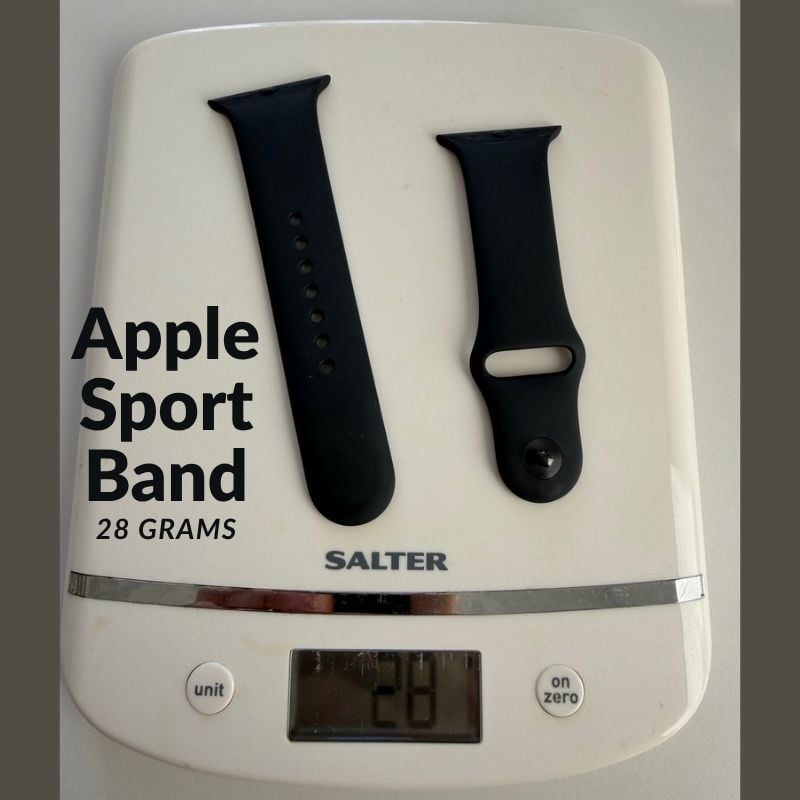
My Experience (3 Years, High-Intensity Use)
This was the lightest and simplest of my three (28 g). It “disappears” under a sleeve, and I found it very comfortable to wear during sleep or long sessions of calisthenics. The pin-and-tuck system is fast, foolproof, and secure — you poke the pin into the hole you want, tuck the tail underneath, and you’re done. No buckles, no flaps, no fuss.
I used it for heavy calisthenics workouts (pull-ups, dips, L-sit, muscle-ups), WOD-style circuit training, cross-training, cycling, and running. In general, it did the job reliably. But there were some tradeoffs:
- After very intense sessions, my wrist sometimes became irritated beneath the band. I suspect limited ventilation/constrained moisture escape.
- During extended cardio runs, sweat buildup under the band was noticeable.
- The band is so thin and close to the skin that any micro-movement can rub, especially if your wrist flexes or the watch shifts slightly.
- Over years, the pin and holes show wear (especially in certain color variants, more visible on light bands).
All that said, I still found it a trustworthy all-rounder, especially if you don’t sweat as profusely or give yourself micro-breaks to wipe your wrist.
What Others Say & Reviews
- TechRadar, in their review, describes the Sport Band as being built from “element-resistant” material, comfortable, and easy to fasten. They do note it is “not ultra-breathable”.
- iMore praises that the Sport Band “excels at its stated purpose: a high-quality band you can use while exercising that doesn’t come loose nor itch the wearer.”
- On Reddit, users often switch between a sport band and a sport loop to reduce sweating or discomfort. Some comment that the strap can “become itchy” after heavy sweat.
- On Apple’s own discussion forums, users mention the Sport Band’s fluoroelastomer as smooth, durable, and water- and sweat-resistant, with a secure pin-and-tuck closure.
Overall, the consensus aligns with my experience: dependable, solid for exercise, but with known tradeoffs if ventilation or skin comfort is your priority.
Materials & Manufacturing Insights
The Sport Band is made of fluoroelastomer — a synthetic rubber-like material with excellent chemical, heat, and UV resistance. It’s the same general class of elastomer that you find in high-performance seals, gaskets, and O-rings, though in a formulation tuned for skin contact, flexibility, and durability.
Why fluoroelastomer is a good choice here:
- It resists stretching or sagging over time relative to cheaper silicones.
- It does not absorb water or sweat, so moisture tends not to soak in (at least ideally).
- It is chemically stable, resisting degradation from body oils, UV exposure, salt, and sweat.
- It has a smooth texture that slides against skin and clothing without snagging.
However, there’s a trade: fluoroelastomer isn’t very porous. That means it’s harder for trapped moisture (sweat, water) to escape through the material. Also, its smoothness means it can cling to skin or cloth surfaces when wet.
In manufacturing, elastomeric bands are typically molded in a clamshell injection process, with coloration (pigments or masterbatch) and post-curing steps to stabilize properties. Apple likely also subjects bands to UV or ozone aging tests, mechanical fatigue tests (pin cycles, bending, tearing) and chemical resistance tests to ensure they maintain performance over years.
A challenge is that over time (especially with heavy use), localized stress on the holes or pin mechanism can lead to micro-cracks or deformation, especially in thinner areas. That’s why I observed slight wear in hole edges after multi-year use. High-end manufacturers may reinforce these zones or do post-processing (annealing) to reduce stress concentrations.
Practical Tips & Tricks
- Alternate tightness — when you rest (e.g., during warm-ups or in between circuits), loosen slightly. That gives your skin some breathing room.
- Wipe mid-session — keep a small cloth or sweat rag and occasionally lift the band to clear moisture underneath.
- Rotate with another band — if you have two Sport Bands, alternate to let one fully dry and recover.
- Pay attention to fit near the lugs — avoid tension concentrates right at the edges of the band closure.
- Cleaning — wash with mild soap and water; avoid harsh solvents or alcohol as they may degrade pigmentation or reduce flex fatigue life.
- Inspect holes periodically — if edges start to fray, consider retiring or replacing.
If ventilation or skin irritation is a serious issue for you, you’ll want to look to bands that allow more airflow or mesh structures. That leads us to the other two in my tested set.
2. Apple Ocean Band
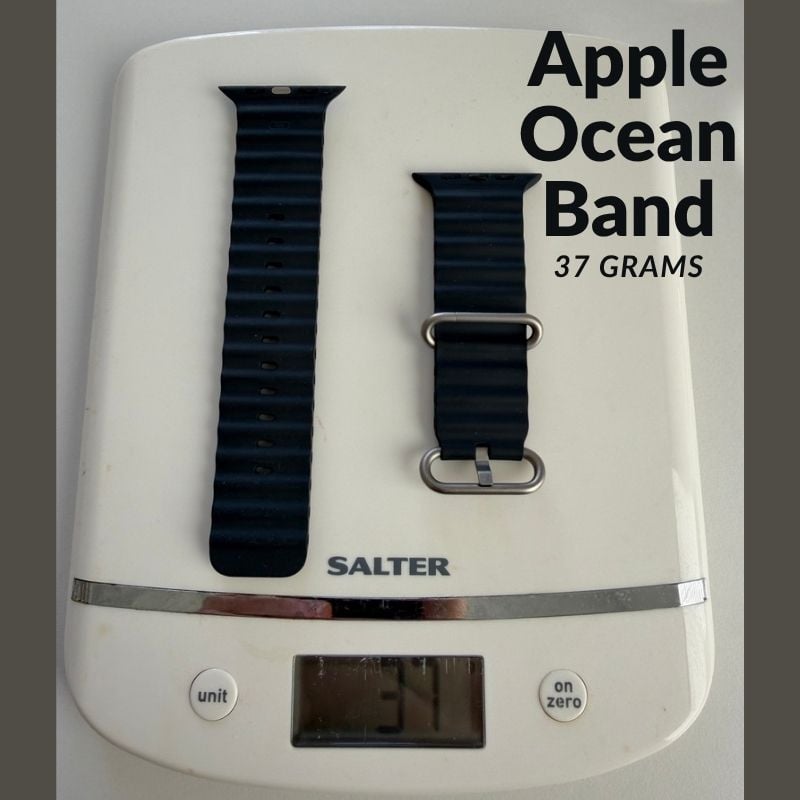
My Experience
I’ll come out and say it: the Ocean Band is the most visually striking of the three. It complements the rugged, adventure-oriented aesthetic of the Ultra. It’s not subtle — it’s a statement. When I wear it, people notice. But more than that, it offers its own functional appeal in the right use cases.
At 37 g (the heaviest among my three), it’s bulkier and stands proud on the wrist. It uses a more traditional clasp mechanism (with a pill-shaped locking clasp, as part of a fold-over or tuck-in system). You have to initially set it for your wrist size (i.e. pick which hole the clasp slug plugs into), so it’s less “just pick and wear” than the Sport Band.
During workouts, I noticed less sweating under the band versus the Sport Band. It ventilates better — albeit a modest improvement — which helps with long-duration cardio or hot conditions. But there were tradeoffs:
- Because of its bulk and clasp design, tucking it beneath a shirt sleeve or wearing it in tighter clothing is challenging.
- For sleep, it’s heavier and less “barely there,” so I often favored other bands for overnight wear.
- On ultra-long sessions (multi-hour rides), the clasp and strap engage in more bending, which sometimes made micro-adjustments necessary.
In my judgment, the Ocean Band is fantastic when you want a rugged, sporty aesthetic (especially if you’re doing open-water swims or want a band that visually “matches” the Ultra). But I don’t use it 100% of the time, because sometimes the comfort/ventilation tradeoff matters more.
What Others Say & Reviews
- DCRainmaker, in a detailed test of Ultra bands, remarks that the Ocean Band is “technically not a loop” despite some confusing “little noodle-like loops.” The clasp is interesting and somewhat unique, with a metal locking mechanism.
- The Verge, in its Ultra strap review, notes that the Ocean Band’s adjustable clasp is “fiddly” and less fun to manipulate than simpler bands. They also mention that the band only comes in one size, so users with small wrists sometimes end up having a small strap tail left over.
- Some users love the bold look but caution that on slimmer wrists, the clasp positioning or excess strap tail may be awkward.
- In community threads, some owners mention the band excels in diving or wetsuit-compatible use, because its extension piece and robust clasp gives you flexibility over tight suits.
Overall, opinions tend to be split: some adore its rugged looks and “sporty over-engineered” character, others find it bulky or cumbersome in everyday use.
Materials & Design Considerations
The Ocean Band uses a fluoroelastomer “noodle” loops design (i.e. many thin interwoven loops of elastomer), combined with titanium hardware in the clasp and interface. DCRainmaker notes it’s not a true continuous loop but engineered to provide stretch and compliance while preserving structural integrity.
Why that design?
- The noodle-style loops can flex, stretch slightly, and compress in areas during motion, giving a blend of firmness and compliance.
- Multiple small loops give micro-ventilation paths (air gaps among loops) and allow quick drainage of water or sweat.
- Titanium hardware offers high strength, corrosion resistance, and a finish that matches the Ultra’s rugged aesthetic.
Because the clasp is metal and under load, Apple must ensure very tight tolerances, fatigue resistance, locking reliability, and corrosion protection (especially given exposure to salt water or chlorine). That involves precision machining, surface treatments (like anodization or passivation), and rigorous QC.
One downside: since the loops are individually molded and assembled, stress concentration points (loop-to-connector junctions) are more complex than in a simple molded band. Those junctions must be robust to repeated bending, load, and UV exposure.
Practical Tips & Tricks
- Initial setup: take time to test multiple clasp hole positions to find one where the tail lies flush but doesn’t interfere with comfort or snagging.
- Don’t over-tighten — since it has more structural rigidity, overtightening can increase pressure in tight bends or edges.
- Rinse after salt or pool use — unless you’re using fresh water, always rinse the band and clasp hardware.
- Regular inspection of loops — occasionally check loops near the clasp for wear or micro-tears.
- Rotate for sleep — given its bulk, it may not be ideal for overnight use (unless your wrist tolerates it).
- Use on outdoor or water adventures — this band shines when you’re doing wet outdoor workouts, diving, open-water swims (within the constraints of sensor accuracy), or rugged training.
For someone like me, it’s a fun and capable option that I reserve for sessions where I want that “rugged Ultra look” and water-related use. But I don’t make it my everyday band.
3. Apple Titanium Milanese Loop
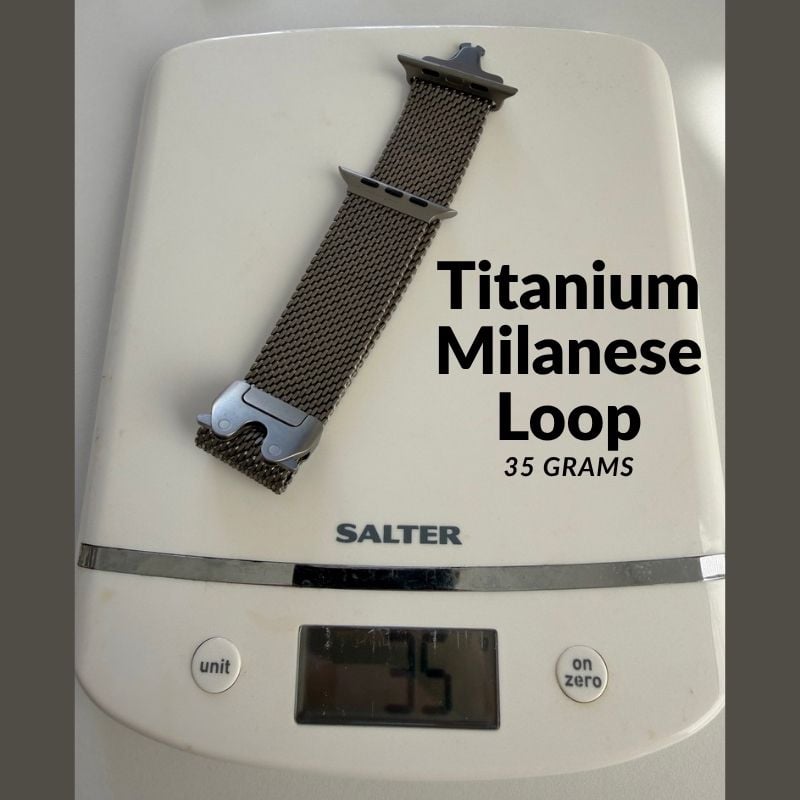
My Experience (Big Surprise Winner)
This was the band I originally thought would be elegant-but-impractical. After all, “metal mesh” often conjures images of weight, heat conduction, or inflexibility. But after extensive testing in calisthenics, cycling, running, strength work and all-day & overnight wear, it surprised me — it’s my current daily driver.
At ~35 g, it’s heavier than the Sport Band but lighter than the Ocean Band. But weight is misleading — the profile is ultra-thin. The mesh design is thin, flexible, and conformed to the wrist contours. In fact, it often felt more subtle under clothing than the Sport Band.
In many workouts, the titanium mesh ventilated far better than either elastomer band. My wrist stayed cooler, less sweaty, and since the mesh lets airflow in, I experienced less skin irritation.
Accuracy-wise, the band held tightly and stably — I saw no perceptible degradation in heart-rate, motion, or calorie data compared to the Sport Band. I tried longer runs, calisthenics sessions, and intensive CrossFit WODs, and things stayed consistent.
In daily work, I wore it to the office, in meetings, and even social settings — it blends elegance with utility. It’s rare to find such a crossover piece that works as well for sport as it does for dress.
The only real negative: the clasp (magnetic/magnetic+mechanical) takes a bit of getting used to. At first, fiddling to align the mesh and clasp was occasionally tricky, but after a few weeks it became second nature, and now it’s seamless.
It’s now my go-to — for workouts, for sleep, for life. If you can afford it and want one band that covers most of your needs, this is the pick I’d recommend most.
What Others Say & Reviews
- Yanko Design describes the Titanium Milanese Loop as “durable, made from aerospace-grade titanium, corrosion-resistant and built to handle tough environments.”
- On Reddit, users call it “the best band in my opinion,” praising the balance of elegance and utility. One user notes once it’s sized properly, you “don’t really mess with it besides a few inches.”
- Some users mention initial confusion with clasp alignment or choosing the right size (since metal mesh is less forgiving), but once set, it’s comfortable and stable.
The sentiment: it’s a sleeper hit. Many doubted it for sport, but now it has fans across casual users, professionals, and fitness buffs.
Materials & Manufacturing Insights
This band is constructed from aerospace-grade titanium mesh — likely Ti-6Al-4V or a similar alloy — with precision machining and mesh weaving.
Advantages of titanium mesh:
- High strength-to-weight ratio — titanium is lighter than steel for comparable strength, so the mesh can be very fine yet durable.
- Excellent corrosion resistance — titanium naturally forms a stable oxide layer that protects from corrosion, even in salt water.
- Temperature stability — does not conduct heat as aggressively as steel, so it’s less likely to feel “cold metal” against skin.
- Biocompatibility — titanium is commonly used in implants and jewelry because it’s generally very friendly to skin and less likely to cause allergic reactions.
In manufacturing, creating a fine, flexible mesh in titanium involves delicate techniques: wire drawing, weaving, precise mesh spacing, edge finishing (to prevent sharp edges), and post-processing (polishing, passivation, surface smoothing). The clasp hardware must align cleanly with the mesh (using magnetic or mechanical locking) and withstand cyclical loading and fatigue without loosening over years.
One key risk is mesh fatigue — repeated bending or kinking over time can cause micro-cracks if not designed properly. But Apple’s execution seems to have mitigated this, at least in my three years of use.
Practical Tips & Tricks
- Get the sizing right up front — when you first adjust, test for snug-but-not-tight. The mesh is less forgiving than a silicone band.
- Smooth clasp connections — make sure the clasp’s magnetic/locking surface is clean and aligned; any debris may interfere.
- Avoid sharp bends — don’t kink or fold the mesh too sharply during use or storage.
- Occasional cleaning — the mesh can collect micro dust or debris; use a soft brush (dry or slightly damp) to clean between links.
- Rotate stress points — when wearing, try to avoid constantly bending at the same exact point.
- Be gentle removing/onboarding — metal bands can catch on edges; avoid aggressive twisting that might deform links.
For me, it has proven tough in sport, elegant in daily life, and comfortable for sleep. It bridges the gap between utility and aesthetics more than I expected.
Why I Dropped the Trail Loop (and Why Many Others Do)
Because you asked, here’s a quick word on why the Trail Loop didn’t make my top three — and why many users echo the same concerns.
The Trail Loop is a woven fabric (nylon) loop with hook-and-loop (Velcro) adjustment. It’s lightweight, breathable, and comfortable — but in intense sweat/water scenarios, the downsides emerge:
- The fabric gets wet and stays wet (or at least slower to dry). That leads to a clammy feeling, odor, and potential degradation of comfort.
- Over months, especially under stress, the Velcro fastening performance deteriorates — I found that after ~6 months, the grip weakened, making me less confident in it during high-motion workouts.
- It is more exposed to snagging or catching (on equipment, clothing, etc.).
- In showers or swimming, it retains water more than elastomer bands.
Many users on Apple forums and Reddit also complain about similar issues: “mesh on the loop eventually stinks,” “becomes itchy sometimes,” or “I avoid the fabric when sweat is heavy.”
In short: it’s great for light workouts or casual wear, but for high-intensity, high-moisture use, I found it suboptimal. That’s why I didn’t include it among my favorites.
TLDR Summary: Strengths, Tradeoffs & Use-Case Matrix
Here’s how I’d summarize my three bands side-by-side based on all my experience and the broader user feedback.
| Feature | Sport Band | Ocean Band | Titanium Milanese Loop |
|---|---|---|---|
| Weight | 28 g – Lightest of the three | 37 g – Heaviest and bulkiest | 35 g – Mid-range weight |
| Material | Fluoroelastomer (smooth rubber) | Fluoroelastomer with titanium clasp | Aerospace-grade titanium mesh |
| Ventilation | Limited – can trap sweat | Good – ridged loops create airflow | Excellent – fully ventilated mesh |
| Comfort (Daytime) | Very comfortable under sleeves | Moderate – can press on wrist | Extremely comfortable and flexible |
| Comfort (Sleep) | Excellent for sleep tracking | Poor – clasp digs in | Excellent – cool, thin mesh |
| Fit & Adjustability | Easy pin-and-tuck system | Manual clasp setup, fixed holes | Magnetic clasp – easy micro-adjustment |
| Ease of Use | Fast on/off, secure | Slightly fiddly clasp | Quick once you get used to it |
| Durability | Great – minor wear after years | Excellent – titanium hardware | Excellent – resists corrosion, no odor |
| Sweat & Water Resistance | Sweatproof and waterproof | Best for diving/swimming | Resistant to sweat, dries instantly |
| Aesthetics | Minimal and sporty | Bold, rugged, “tool watch” vibe | Sleek and elegant, office-ready |
| Security During Workouts | Stable and reliable | Very secure once fastened | Secure; clasp needs correct tension |
| Best For | HIIT, running, sleep tracking | Outdoor, water sports, rugged use | All-day wear, cycling, calisthenics |
| Main Weakness | Poor ventilation in heat | Bulky, uncomfortable for sleep | Pricey; clasp has small learning curve |
| Typical Price | 💲 49 USD | 💲 99 USD | 💲 199 USD |
| Best Deals | Sport Band on Amazon | Ocean Band on Amazon | Titanium Milanese Loop on Amazon |
| Overall Rating | ⭐⭐⭐☆☆ | ⭐⭐⭐⭐☆ | ⭐⭐⭐⭐⭐ |
WARNING: To avoid conterfeit fake products make sure you shop from Apple's official Amazon store!
From my experience:
- If I want a “do-it-all” and can accept the price, the Titanium Milanese Loop is my top pick.
- If you’re doing water training, rugged adventure, or want the boldest aesthetic, Ocean Band is a solid secondary.
- The Sport Band is a reliable, lower-cost, proven fallback and works excellently — especially if you don’t push extreme sweat or heat often.
I personally rotate between the Milanese and Sport Band for everyday wear and workouts, and reserve the Ocean for sessions when I want extra ruggedness or in water.
How Bands Interact with Fitness Tracking & Accuracy
One thing I pushed myself to test: did switching bands affect metrics like heart rate, step count, calorie burn, or SpO₂ readings? Put simply: yes — but only if the band fits poorly or shifts. A loose strap, micro-slippage, or air gap will degrade data quality.
Why Fit Matters for Tracking
Sensors (optical heart rate, SpO₂, accelerometers) rely on consistent contact with skin and minimal relative movement. If the band shifts, even slightly, you introduce noise or dropouts. As one review put it in a running context:
“A band that’s even slightly too loose can throw off heart rate readings pretty easily.”
Thus, a band might be great material-wise, but if it lets the watch wobble, your accuracy takes a hit.
My Findings
- With the Sport Band and Milanese properly tightened, readings remained stable and consistent, even in high-intensity intervals, heavy sweats, and fast transitions.
- With the Ocean Band, I had to ensure the clasp was solid and tail tucked — otherwise I saw occasional brief dips in heart rate during extreme wrist flexes.
- In a few test runs where I intentionally “loosened” the Milanese slightly, I did see small anomalies in HR and cadence tracking (but that’s expected).
- Over weeks, I did not detect drift attributable to band aging (i.e. sensor alignment didn’t worsen noticeably).
In practical terms: once you find a band/size combination that holds the watch stably, the tracking performance becomes more about the watch hardware, algorithm, and external conditions than the strap. But a bad band choice or poor fit will always sabotage even the best sensor.
Sleep, Recovery & Overnight Use
One requirement I had: the band had to be comfortable overnight, as I track sleep (heart rate variability, breathing rate, SpO₂). I found:
- The Sport Band — very comfortable; nearly “invisible” during side-sleep.
- The Milanese — surprisingly comfortable; thin and smooth mesh doesn’t pinch or dig in, though heavier than silicone.
- The Ocean — less ideal for deep sleep; bulk and clasp edges can be felt when your wrist presses against bedding.
If overnight comfort is a priority, I lean toward these two over the Ocean for all-night use.
Practical Recommendations: How to Choose & Use Bands Wisely
Here are my distilled recommendations, based on years of trial, research, and user input.
1. Don’t chase a single “perfect band” — rotate.
Even the best band may have minor tradeoffs. Keep a backup (e.g. alternate Milanese and Sport or Ocean) so you can let materials rest, dry, and last longer.
2. Prioritize fit over aesthetics (initially).
When you first get a band, spend time adjusting, testing in motion, doing a sweaty session, and checking if readings stay clean. Don’t just base it on how “beautiful” it looks — a beautiful but loose band is worse than a solid but plain one.
3. Mid-workout check-ins help.
It’s worth carrying a microfiber cloth or small towel, and occasionally lifting/tightening the band mid-session (especially during long rides or WODs). This improves comfort and sensor consistency.
4. Post-sweat care is key.
After heavy sweat or water exposure, always rinse the band (fresh water) and dry thoroughly (air, not heat). This prolongs material life, reduces odor, and keeps hardware corrosion minimal.
5. Inspect regularly.
Every few months, check pin ends, clasp latches, loops (in Ocean), mesh junctions (in Milanese), and band holes. Any signs of fraying, microcracks, or loosening indicate time for replacement.
6. Use lighter bands for prolonged cardio/heat sessions.
If you’re doing very long runs or rides in high heat, favor the band with the best ventilation for that session — i.e. Milanese or Ocean over the standard Sport.
7. Have a default “go-to” band.
Pick one band you trust 80% of the time (for you, it’s the Milanese) and keep that as your default. Use others situationally (water, extreme heat, style).
Final Thoughts & My Recommendation
After testing so long and hard, if someone asked me: “What’s the one Apple Watch Ultra band I should get?” — I’d point them toward the Titanium Milanese Loop. It’s elegant, surprisingly robust in performance, comfortable for every use including workouts and sleep, and makes your Ultra look sharp without sacrificing utility.
But I’d caveat: if your budget, sweat profile, or style needs differ, you can absolutely build a practical two- or three-band rotation that covers every case. The Sport Band remains a time-tested, reliable workhorse. The Ocean Band is your go-to when water, outdoor ruggedness, and bold looks matter most.
If readers of Calisthenics.com ask me which to choose: start with Milanese if funds allow, supplement with Sport or Ocean, and rotate. Don’t neglect fit and mid-session care — those small practices make a difference in comfort, data accuracy, and longevity.

